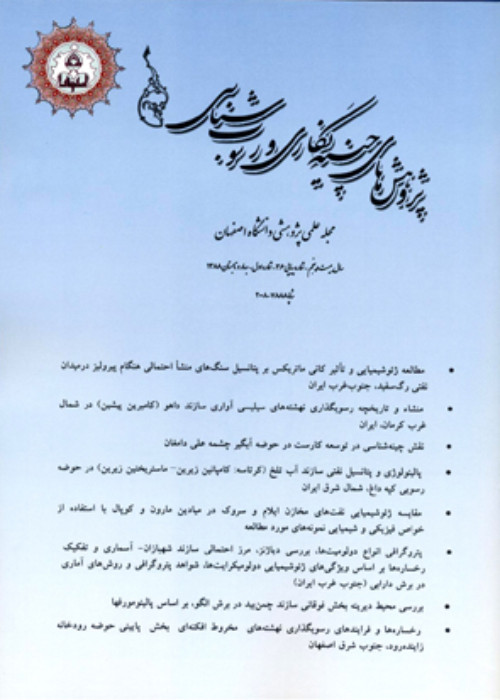Reappraisal of lithology and depositional environment of carbonate-siliciclastic succession of the Pabdeh Formation in SE Ilam Province, W Iran
Author(s):
Article Type:
Research/Original Article (دارای رتبه معتبر)
Abstract:
Abstract
The Pabdeh Formation (Paleocene–Oligocene) is located in the Zagros foreland basin. This formation was well appreciated as a source rock and somehow a potential reservoir particularly in the Dezful Embayment. Although it has been less appreciated due to overwhelming fine grained lithology in the majority of the Zagros basin. Microfacies analysis and depositional environment of the Pabdeh Formation was studied by examining 500 samples collected from three surface sections namely Malekshahi, Gandab and Pirmohammad, which are located around the Malekshahi city. Based on petrography, proportional abundance of foraminifera and other constituents, texture and microfacies characterizes, eight facies associations were recognized which were deposited in three facies belts on a ramp. As a whole, the Pabdeh Formation comprises marl and limestone beds. Based on geochemical analysis (calcimetry and XRF analysis), the marl lithofacies was established, although it was literally described as shale. Wet chemical oxidation method was employed to determine the organic matter content of some selected samples, which revealed relatively higher organic matter content in marlstones.
Introduction
A mixed carbonate-clastic system may develop, once clastic input exerted into a ramp environment. Such intervals are defined with shale, sandstone and carbonate beds (Tucker 2003). Marl could deposited instead of shale, if the clastic input are limited (Holland 1993). Periods of clastic input in such environments are probably linked to sea-level changes. In present research, the Pabdeh Formation is proposed as a typical carbonate-clastic sedimentation, which was deposited during Paleocene–Oligocene in the Zagros foreland basin. The Zagros basin comprises a thick sedimentary succession over the Precambrian basement (Alavi 2004). The basin was a part of Gondwana supercontinent during Paleozoic which was bordered by Paleotethys in the north, a passive margin during Mesozoic and a convergent orogenic belt in Cenozoic (Bahroudi and Koyi 2004; Sepehr and Cosgrove 2004). The Neotethys was initiated since Late Triassic between Iran and the Arabian plate (Berberian and King 1981; Sepehr and Cosgrove 2004), and ceased during late Cretaceous due converging movement of subducting Arabian Plate beneath the Iran sub-plate (Berberian and King 1981; Stoneley 1981; Berberian 1995). Continental collision in Cenozoic led to the formation a Zagros fold-thrust belt and foreland basin where since Late Cretaceous onward, sedimentation continued without any major break. The succession includes the Gurpi (shale and marl), Amiran (siltstone, sandstone, limestone and conglomerate), Pabdeh (argillaceous limestone, shale and marl), Taleh Zang (limestone), Kashkan (siltstone, sandstone and conglomerate), Shahbazan (dolomitic limestone and dolostone), Asmari (limestone), Gachsaran (anhydrite, marl and limestone) and Aghajari formations (calcareous sandstone, siltstone and sandstone) (James and Wynd 1965). During Paleocene–Eocene the argillaceous limestone and pelagic marls of the Pabdeh Formation were deposited in the middle part of the Zagros basin in a ramp setting (intrashelf basin) (Motiei 1993; Mohseni et al. 2011). The Pabdeh Formation was subject of numerous researches since it is considered as a potential source interval. For example Mohseni et al. (2011) untilized trace fossils for interpreting the depositional environment and recognizing turbidity currents (Mohseni and Al-Asam 2004; Khodabakhsh et al. 2009; Mohseni et al. 2011). Khavari et al. (2014) and Senemari (2018) examined the nanostratigraphy and paleoechology of the Pabdeh Formation. This formation is well defined by the purple shale member at the base with Gurpi Formation and conformably underlies by the Asmari Formation (Motiei 1993) and laterally passes into the Kashkan and Shahbazan formations (Alavi 2004). Although James and Wynd (1965) described the Pabdeh Formation as shale interval with subordinate limestone beds, recent studies revealed a major part of this formation includes limestones which were deposited in ramp setting (Mohseni 2003; Behbahani 2006). Since a major part of the so called shales beds are recognized here as marls, the main goal of this research is examining microfacies, depositional environment and petrographic reappraisal of the formation in three selected surface sections around the Malekshahi County using geochemical approaches.
Materials and Methods
Microfacies analysis and depositional environment of the Pabdeh Formation was studied by examining 500 samples collected from three surface sections namely Malekshahi, Gandab and Pirmohammad, which are located around the Malekshahi city (southeast Ilam Province, the Zagros basin; Iran). Petrographic investigations of the rhythmites was performed by using polarizing microscope (Zeiss, Axioscope, 40) on three intervals comprising pronounced rhythms. The nomenclatures of lithofacies are based on Dunham (1962) and Pettijohn (1987). Element composition was measured by S4 Explorer/ x-ray Spectrometry-Bruker (WD XRF) in XRF analysis laboratory at Yazd University. The carbonate content (= CaCO3%) were determined by titration method (Carver, 1971). The organic matter content was determined via wet chemical oxidation (by hydrogen peroxide) (Lewis and McConchie 1994).
Discussion of Results and Conclusions
As a whole, the Pabdeh Formation comprises marl and limestone beds. Distinction between marl/limy marl and limestone beds was done based on geochemical analysis (calcimetry and XRF analysis). Although marl lithofacies was literally described as shale. Wet chemical oxidation method was employed to determine the organic matter content of some selected samples, which revealed relatively higher organic matter content in marlstones. Based on petrography, proportional abundance of foraminifera and other constituents, texture and microfacies characterizes, three micro/lithofacies associations were recognized within the selected rhythms which were deposited in three facies belts on a carbonate ramp environment: A) Inner Ramp, include the following microfacies (MF): MF A1- Bioclastic mudstone with extraclast and quartz MF A2- Oncoid bioclastic wackestone-packstone MF A3- Ooid packstone B) Middle Ramp, include the following microfacies and lithofacies (LF): MF B1- Algal bioclastic packstone MF B2- Bioclastic mudstone-packstone with benthic foraminifera and echinoderm LF B3- Marl/calcareous marl lithofacies C) Outer Ramp, include the following microfacies and lithofacies (LF): MF C1- Bioclastic mudstone-packstone with planktonic foraminifera and glauconite LF C2- Marl/calcareous marl lithofacies Two lithofacies (LF C2 and B3) alternate with the recognized limestone microfacies (as described above) resulting two cycle types: 1- Alternation of LFC2 with microfacies type C (LF C-MF C cycle) 2- Alternation of LFB3 with microfacies type B (LF B-MF B cycle) Sedimentation in the ramp environment may be affected by clastic input (mainly as event deposits). In some cases, more than 90% of basins was filled by these evenest (i.e. tempestite/turbidites; Colombie et al., 2012). The cyclic (=rhythmite) deposition of micro/lithofacies in the study area indicate two depositional mechanisms: 1) background in-situ sedimentation (carbonate facies), 2) fine clastics transported by traction currents from shallow-marine that dumped siliciclastics into the deep-marine. The latter mechanism show characters of event deposits as it was reported by Khodabakhsh et al. (2009) and Mohseni et al. (2011). Limestone-marl alternations in the Pabdeh Formation was possibly controlled by periodic fluctuations in siliciclastic input by shallow-water derived currents (probably turbidity currents). The trace fossils of Zoophycos group are normally associated with turbidites and debris flows in ramp environments. Frequent occurrences of such trace fossils in the study area could be assigned to event deposits. This study revealed the Pabdeh Formation comprise 8 microfacies deposited in a carbonate ramp. The Zoophycos trace fossil displaying an evolutionary change in acceding order which suggest shift from more calm water setting toward relatively agitated condition upward throughout the formation. Marlstone lithofacies is consistently distributed throughout the whole section, which was described literally as shale beds. Relatively more Al2O3 content of marlstones in compare to limestone beds could imply more clastic input during deposition of these beds.Language:
Persian
Published:
Stratigraphy and Sedimentology Researches, Volume:34 Issue: 4, 2018
Pages:
57 to 82
magiran.com/p2006603
دانلود و مطالعه متن این مقاله با یکی از روشهای زیر امکان پذیر است:
اشتراک شخصی
با عضویت و پرداخت آنلاین حق اشتراک یکساله به مبلغ 1,390,000ريال میتوانید 70 عنوان مطلب دانلود کنید!
اشتراک سازمانی
به کتابخانه دانشگاه یا محل کار خود پیشنهاد کنید تا اشتراک سازمانی این پایگاه را برای دسترسی نامحدود همه کاربران به متن مطالب تهیه نمایند!
توجه!
- حق عضویت دریافتی صرف حمایت از نشریات عضو و نگهداری، تکمیل و توسعه مگیران میشود.
- پرداخت حق اشتراک و دانلود مقالات اجازه بازنشر آن در سایر رسانههای چاپی و دیجیتال را به کاربر نمیدهد.
In order to view content subscription is required
Personal subscription
Subscribe magiran.com for 70 € euros via PayPal and download 70 articles during a year.
Organization subscription
Please contact us to subscribe your university or library for unlimited access!




